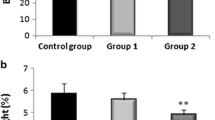Abstract
Treatment of mice of the A2G-hr/+ congenic line with 2, 3, 7, 8-tetrachlorodibenzo-p-dioxin (TCDD) resulted in the development of hepatic porphyria over a period of 4 weeks. Female mice responded to a lesser extent than did males. The degree of porphyria in haired heterozygotes (hr/+) was less than in the corresponding hairless homozygotes (hr/hr) and the haired mice had lower resting metabolic rates than hairless mice. Adaptation of mice of either genotype to a 32–33 °C environment resulted in a decrease in resting metabolic rate and a reduction in hepatic porphyrin levels. Histologically-demonstrated necrotic changes in livers were accompanied by increased activity of alanine aminotransferase and sorbitol dehydrogenase in the plasma; however, there was no clear temporal trend in plasma enzyme levels. Elevated environmental temperature reduced the plasma alanine aminotransferase activity. The study provided evidence for a pleiotropic effect of variation at the hr locus being expressed in TCDD hepatotoxicity. Suggestions for mechanisms whereby the effect can be mediated through alterations in resting metabolic rate are made.
Similar content being viewed by others
References
Donnelly HT (1982) Oxygen consumption, activity and body fat in normal and hairless mice. Lab Anim 16: 167–171
Doss M, Sauer H, von Tiepermann R, Colombi AM (1984) Development of chronic hepatic porphyria (porphyria cutanea tarda) with inherited uroporphyrinogen decarboxylase deficiency under exposure to dioxin. Int J Biochem 16: 369–373
Francis JE, Smith AG (1984) Assay of mouse liver uroporphyrinogen decarboxylase by reverse-phase high-performance liquid chromatography. Anal Biochem 138: 404–410
Gasiewicz TA, Geiger LE, Rucci G, Neal RA (1983) Distribution, excretion, and metabolism of 2,3,7,8-tetrachlorodibenzo-p-dioxin in C57BL/6J, DBA2/J, and B6D2F1/J mice. Drug Metab Dispos 11: 397–403
Goldstein JA, Hickman P, Bergman H, Vos JG (1973) Hepatic porphyria induced by 2,3,7,8-tetrachlorodibenzo-p-dioxin in the mouse. Res Commun Chem Pathol Pharmacol 6: 919–928
Greig J (1984) Differences between skin and liver toxicity of 2,3,7,8-tetrachlorodibenzo-p-dioxin in mice. In: Poland A, Kimbrough RD (eds) Cold Spring Harbor Laboratory, USA (Banbury Report, vol 18, pp 391–396)
Greig JB, Jones G, Butler WH, Barnes JM (1973) Toxic effects of 2,3,7,8-tetrachlorodibenzo-p-dioxin. Food Cosmet Toxicol 11: 585–595
Greig JB, Francis JE, Kay SJE, Lovell DP, Smith AG (1984) Incomplete correlation of 2,3,7,8-tetrachlorodibenzo-p-dioxin hepatotoxicity with Ah phenotype in mice. Toxicol Appl Pharmacol 74: 17–25
Hilkens J, Hilgers J (1980) Genetic relationships between inbred mouse strains maintained in the Netherlands Cancer Institute (NCI). In: Spiegel A, Erichsen S, Solleveld HA (eds) Animal quality and models in biomedical research. Gustav Fischer Verlag, Stuttgart New York (7th ICLAS Symposium, Utrecht 1979, pp 353–359)
Jones G, Greig JB (1975) Pathological changes in the liver of mice given 2,3,7,8-tetrachlorodibenzo-p-dioxin. Experientia 31: 1315–1316
Jones KG, Sweeney GD (1980) Dependence of the porphyrinogenic effect of 2, 3, 7, 8-tetrachlorodibenzo-(p)-dioxin upon inheritance of aryl hydrocarbon hydroxylase responsiveness. Toxicol Appl Pharmacol 53: 42–49
Jones KG, Cole FM, Sweeney GD (1981) The role of iron in the toxicity of 2,3,7,8-tetrachlorodibenzo-(p)-dioxin. Toxicol Appl Pharmacol 61: 74–88
Kappas A, Sassa S, Anderson KE (1983) The porphyrias, In: Stanbury JB, Wyngaarden JG, Frederickson DS, Goldstein JL, Brown MS (eds) The metabolic basis of inherited disease, 5th ed. McGraw-Hill, New York, pp 1301–1384
Kimbrough RD (1984) Skin lesions in animals and humans: a brief overview. In: Poland A, Kimbrough RD (eds) Cold Spring Harbor Laboratory, USA (Banbury Report, vol 18, pp 357–363)
Knutson JC, Poland A (1982) Response of murine epidermis to 2,3,7,8-tetrachlorodibenzo-p-dioxin: interaction of the Ah and hr loci. Cell 30: 225–234
Lowry OH, Rosebrough NJ, Farr AL, Randall RJ (1951) Protein measurement with the Folin phenol reagent. J Biol Chem 193: 265–275
Nagarkatti PS, Sweeney GD, Gauldie J, Clark DA (1984) Sensitivity to suppression of cytotoxic T cell generation by 2,3,7,8-tetrachlorodibenzo-p-dioxin (TCDD) is dependent on the Ah genotype of the murine host. Toxicol Appl Pharmacol 72: 169–176
Nebert DW (1978) Genetic differences in microsomal electron transport: the Ah locus. Methods Enzymol 52: 226–240
Neubert D, Zens P, Rothenwallner A, Merker H-J (1973) A survey of the embryotoxic effects of TCDD in mammalian species. Environ Health Perspect 5: 67–69
Poland A, Glover E (1980) 2,3,7,8-Tetrachlorodibenzo-p-dioxin: segregation of toxicity with the Ah locus. Mol Pharmacol 17: 86–94
Poland A, Palen D, Glover E (1982) Tumour promotion by TCDD in skin of HRS/J hairless mice. Nature 300: 271–273
Puhvel SM, Sakamoto M, Ertl DC, Reisner RM (1982) Hairless mice as models for chloracne: a study of cutaneous changes induced by topical application of established chloracnegens. Toxicol Appl Pharmacol 64: 492–503
Ray DE (1980) Selective inhibition of thermogenesis by tributyl S,S,S-phosphorotrithioate (DEF). Br J Pharmacol 69: 257–264
Smith AG, Francis JE, Kay SJE, Greig JB (1981) Hepatic toxicity and uroporphyrinogen decarboxylase activity following a single dose of 2,3,7,8-tetrachlorodibenzo-p-dioxin to mice. Biochem Pharmacol 30: 2825–2830
Stanier MW (1977) Effect of environmental temperature and food intake on the distribution of fat in growing hairless mice. Br J Nutr 37: 279–284
Vos JG, Moore JA, Zinkl JG (1974) Toxicity of 2, 3, 7, 8-tetrachlorodibenzo-p-dioxin (TCDD) in C57Bl/6 mice. Toxicol Appl Pharmacol 29: 229–241
Vos JG, Van Leeuwen FXR, De Jong P (1982) Acnegenic activity of 3-methylcholanthrene and benzo[a]pyrene, and a comparative study with 2,3,7,8-tetrachlorodibenzo-p-dioxin in the rabbit and hairless mouse. Toxicology 23: 187–196
Author information
Authors and Affiliations
Rights and permissions
About this article
Cite this article
Greig, J.B., Francis, J.E., Kay, S.J.E. et al. Pleiotropic effect of the gene hairless on hepatotoxicity of 2, 3, 7, 8-tetrachlorodibenzo-p-dioxin in mice. Arch Toxicol 60, 350–354 (1987). https://doi.org/10.1007/BF00295754
Received:
Accepted:
Issue Date:
DOI: https://doi.org/10.1007/BF00295754




